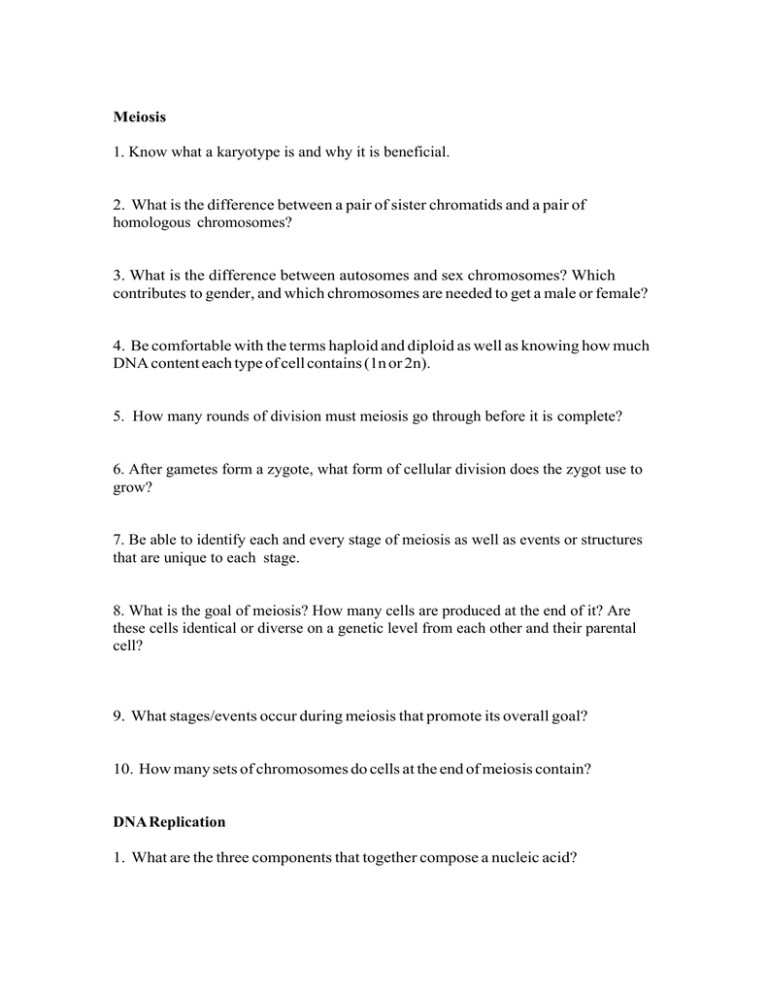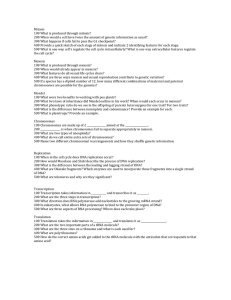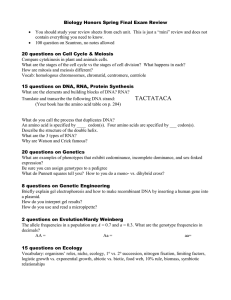1. Know what a karyotype is and why it is... 2. What is the difference between a pair of... Meiosis
advertisement

Meiosis 1. Know what a karyotype is and why it is beneficial. 2. What is the difference between a pair of sister chromatids and a pair of homologous chromosomes? 3. What is the difference between autosomes and sex chromosomes? Which contributes to gender, and which chromosomes are needed to get a male or female? 4. Be comfortable with the terms haploid and diploid as well as knowing how much DNA content each type of cell contains (1n or 2n). 5. How many rounds of division must meiosis go through before it is complete? 6. After gametes form a zygote, what form of cellular division does the zygot use to grow? 7. Be able to identify each and every stage of meiosis as well as events or structures that are unique to each stage. 8. What is the goal of meiosis? How many cells are produced at the end of it? Are these cells identical or diverse on a genetic level from each other and their parental cell? 9. What stages/events occur during meiosis that promote its overall goal? 10. How many sets of chromosomes do cells at the end of meiosis contain? DNA Replication 1. What are the three components that together compose a nucleic acid? 2. Know what the structure looks like, as well as what bases pair up. Know the bonds that exist between a base and another base compared to those that exist between a base and the backbone of the molecule. 3. How do the bases pair up? How many bonds exist between each pair? 4. Know how to create a complimentary strand of DNA if you are given a template strand. 5. Know the structures, enzymes, and steps that are required for DNA replication to occur. 6. Know the direction that DNA is made in compared to the direction in which it is “read.” 7. What causes there to be a leading and lagging strand in a molecule of DNA when it is being replicated and what are Okazaki fragments? 8. Know about the ways that DNA can prevent incorrect pairing of bases when replication has occurred. 9. What is the importance of telomeres? How do our cells maintain their integrity? Can too much maintenance be a bad thing? Protein Synthesis 1. Know the processes involved in creating RNA from DNA and protein from RNA. 2. Know what events and molecules are involved in Transcription and Translation. 3. Know the differences between DNA and RNA. 4. Understand how to read a codon and determine the correct amino acid sequence. 5. Where does transcription begin on a piece of DNA? Where does it end? 6. What are the three stages of transcription? 7. What are some molecules/sequences that facilitate transcription? 8. Why is RNA capped once it is produced? 9. Know the steps of RNA splicing, the proteins involved, as well as the region(s) of RNA that are sliced out or in of the final product. 10. How can your cell produce multiple proteins from the same sequence of DNA? 11. What are the three different types of RNA? How do they differ? How are they similar? 12. Know how tRNA becomes bound to an amino acid as well as how it binds to codons of the mRNA sequence. 13. What are the three sites of the Ribosome that are used in translation and what happens at each site? 14. What is a polysome? What is the benefit to the formation of polysomes? 15. What are the different kinds of point mutations that can occur in a sequence of DNA? How does this affect the amino acids that will be produced?






